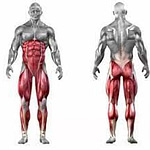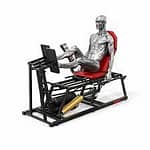Like the deadlift, the squat is one of the most utilised movements in everyday living and is critical to include in your exercise routines. You would be performing this movement numerous times throughout your day without even knowing…. for example, sitting down to eat or even sitting on the toilet!
This exercise engages the majority of muscles in your body, including the stabilising ones around your spine that help with improving posture. Furthermore, adding this exercise will assist with your everyday activities, increase skeletal muscle mass, increase muscle and bone density, reduce the risk of falls and even stimulate certain hormonal processes (in particular testosterone) that in itself has additional benefits.

The weighted squat is one of the three powerlifting exercises, along with the Deadlift and Bench Press. Squats are a compound strength exercise that involves many joint actions and muscle group activations. They are not only used to improve lower body strength, endurance and power but also increase skeletal muscle mass, improve bone mineral density and even hormonal stimulation.
This fundamental movement is an excellent addition to anybody’s exercise program as it recruits nearly every muscle in the lower body and core (plus more!). The squat is also an extremely functional exercise as it simulates many typical movements we perform throughout our daily lives, for example standing up from a chair, getting up and down from the floor and using the toilet.

Squatting is an extremely versatile movement that can be progressed and regressed depending on your experience, strength and mobility. There are many different squat pattern variations that are used to target different muscle groups depending on your goals, current health status and abilities.
Variations include different stances (e.g. wide and narrow), different loading positions (e.g. back squat, front, Goblet squat), changes in foot placement (e.g. heels elevated, pistol squat (single leg), types of resistance (e.g. dumbbells, kettlebells, barbells, resistance bands), changes in speed or tempo and differences in squat depth/range (e.g. quarter, half or full squats) just to name a few.
Each squat variation impacts and alters movement mechanics, and therefore muscle recruitment, so it is important to pick the right variation for your individual needs. This can be provided by an exercise expert if you are unsure.

Squats are one of the most effective exercises for strengthening the entire lower limb. The squat is an extremely functional movement, mimicking many different activities of daily living, making it an ideal choice for general health and fitness training programs. Additionally, squats require a significant amount of recruitment of your lumbo-pelvic-hip complex (pelvis, low back and core) and all your muscles critical for improving and maintaining your posture.
Some of the other health benefits of the squat are;
– Increase muscle size and mass to assist with daily tasks
– Increase BMD (Bone Mineral Density)
– Counteract age-related pathologies – e.g. sarcopenia
– Release of testosterone and other anabolic hormones
– Power development and improvements
– Reduce falls risk
– Improved posture
– Treat and manage low back pain
– Increased core strength & power
– Reduction in blood pressure
– Increase mental health
And many more…
Gradual progression of exercises are critical at avoiding injuries and allowing your connective tissue to adapt to the stimulus applied. When starting out with a new exercise such as the squat, it is recommended you perform an exercise that can be safely and effectively performed. Below are some progressions to follow to perform the perfect squat pattern;
1. Seated Leg Ext & Leg Curl
2. Leg Press
3. Sit to Stand
4. Box Squat
5. Squat
6. Overhead Squat
The squat is one of the three powerlifting exercises, along with the Deadlift and Bench Press. Squats are a compound strength exercise that involves many joint actions and muscle group activations. They are not only used to improve lower body strength, endurance and power but also increase skeletal muscle mass, improve bone mineral density and even hormonal stimulation.
This fundamental movement is an excellent addition to anybody’s exercise program as it recruits nearly every muscle in the lower body and core (plus more!). The squat is also an extremely functional exercise as it simulates many typical movements we perform throughout our daily lives, for example standing up from a chair, getting up and down from the floor and using the toilet.
Squatting is an extremely versatile movement that can be progressed and regressed depending on your experience, strength and mobility. There are many different squat pattern variations that are used to target different muscle groups depending on your goals, current health status and abilities. Variations include different stances (e.g. wide and narrow), different loading positions (e.g. back or front), changes in foot placement (e.g. heels elevated), types of resistance (e.g. dumbbells, kettlebells, barbells, resistance bands), changes in speed or tempo and differences in squat depth/range (e.g. quarter, half or full squats) just to name a few.
Each squat variation impacts and alters movement mechanics, and therefore muscle recruitment, so it is important to pick the right variation for your individual needs. This can be provided by an exercise expert if you are unsure.
Shown below is an example flowchart of how the squatting movement pattern could be progressed, starting from a simple variation that utilises one major muscle group at a time, to more complex movements requiring greater control and recruitment of multiple major muscles groups simultaneously.

In the table below, we have summarized some of the key information about just a few of the many squat variations to help you gain a better understanding of what muscles are recruited, the benefits and safety tips.
| Primary Muscles Recruited (note: there are many other muscles working throughout all squat variations) | Performance & Safety Tips | Main Benefits | |
| Leg Press | Seated – Quadriceps – Glutes – Hamstrings – Calf Muscles – Adductors Lying – Places a greater emphasis on the quadriceps – Secondary muscles include – the glutes, hamstrings & calf muscles | – Position feet on the footplate, approx. hip-width apart. Adjust the seat so your knees are bent to approx. 90 degrees – Brace your abdominals and push through your heels – Avoid locking your knees out at the top of the movement (ensure a slight bend) – Slowly lower yourself back to the starting position – You can change the range of motion, the more bend in your knee the harder it will be. You can also try a single leg to target any potential strength differences between your right and left side. | – The leg press targets the same muscle groups as a traditional barbell back squat, however, it places much less load through the low back – The leg press is great for beginners as it is much less technical than a squat, but still allows you to build lower body strength effectively. – All-round lower body recruitment and strengthening exercise, eliminating the balance and stability of a traditional squat |
| Box Squat | – Glutes – Hamstrings – Quadriceps – Lumbar Spine Muscles & Core | – Set up a box or bench to squat down to – Using a weight of your choice (e.g. barbell, kettlebell, dumbbells) position the weight either across your back or hold it in front of your chest. – Initiate the movement by bracing your core, bending at the knees and shifting your hips back until your glutes make contact with the box/bench – Briefly pause at the bottom before driving through your heels to a standing position. Be sure to keep your core engaged & squeeze your glutes | – This squat variation places more emphasis on the muscles of the posterior chain (glutes, hamstrings and Erector Spinae muscles) as you are squatting backwards (pushing your hips further back) rather than down (as seen in a more traditional back squat). – The addition of the box provides you with feedback on your squat depth and guides your squatting range of motion. This feedback may be beneficial when wanting to focus on technique – All-round lower body recruitment and strengthening exercise. – A very functional movement that simulates many daily activities |
| Barbell Front Squat | – Quadriceps – Glutes – Hamstrings – Abdominals – Lower back (Erector Spinae), upper back – Shoulders | – Set up the barbell at chest height, holding the bar with your hands positioned just wider than shoulder-width apart – Unrack the bar so it is level and touching the top of your chest and front of your shoulders – ensure your elbows are forwards & upwards – Position feet shoulder-width apart, brace your core and bend your knees, lowering into a squat position – Lower until your legs are parallel to the floor then drive back up to stand – ensure your chest remains upright, core engaged and pushing through your heels. | – This variation places a greater emphasis on the anterior muscles of the lower leg (quadriceps muscles) due to the position of the bar. – During a front squat, there are less compressive forces placed through the knee and decreased loading through the low back/lumbar spine and still as effective in terms of muscle recruitment as traditional back squats. – All-round lower body recruitment and strengthening exercise. – A very functional movement that simulates many daily activities |
| Barbell Back Squat | – Quadriceps – Glutes – Hamstrings – Abdominals – Lower back (Erector Spinae), upper back – Shoulders | – Start with a barbell resting across the top of your back (not neck). Set feet up about shoulder-width apart. – Brace your core, bending at the knees and slowly lowering yourself downwards, pushing your hips back, keeping your chest up & back flat. – Continue squatting until your thighs are parallel to the floor. From here push through your heels to return to a standing position | – Due to the posture position of the bar, this squat variation recruits more of the muscles in your posterior chain (Glutes, Hamstrings, Erector Spinae) – All-round lower body recruitment and strengthening exercise. – A very functional movement that simulates many daily activities – Reduce falls risk |
Squats are one of the most effective exercises for strengthening the entire lower limb. The squat is an extremely functional movement, mimicking many different activities of daily living, making it an ideal choice for general health and fitness training programs. Additionally, squats require a significant amount of recruitment of your lumbo-pelvic-hip complex (pelvis, low back and core) and all your muscles critical for improving and maintaining your posture.
Some of the other health benefits of the squat are;
Squats are extremely effective and functional movements that must be a staple in your exercise plan. This compound movement recruits a large number of major muscle groups in your body, leading to significant strength improvements, along with many other health benefits. This movement can be performed by anyone, ensuring you maintain the correct technique throughout. It is important that you are completing a squat variation that is appropriate for your goals, needs and level of fitness. If you need further guidance, please reach out to us and take advantage of a free 15min telehealth consultation with our exercise physiologist.
Written by Kaitlyn Eisenhuth, an Exercise Physiologist at Activ8 Health Club